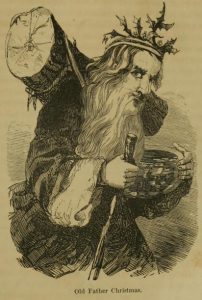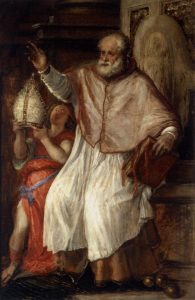 KV writes: “Is it ok for me as a Catholic Christian to give gifts with pictures of Santa Claus on them? … I am concerned that I would be promoting pagan worship if I gave gifts with Santa images on them. Is this the case, or am I being too scrupulous?”
KV writes: “Is it ok for me as a Catholic Christian to give gifts with pictures of Santa Claus on them? … I am concerned that I would be promoting pagan worship if I gave gifts with Santa images on them. Is this the case, or am I being too scrupulous?”
You are not being too scrupulous, KV, and this is a great question that gives us an excellent opportunity to set the record straight about Santa Claus.
For those who are wondering about the origins of Santa, I’m happy to report that even though he has become a secular symbol of Christmas, in reality he has no connection to pagan worship and is derived from a very saintly Catholic bishop named Nicholas of Myra.
According to Father Joseph Marquis at the St. Nicholas Institute, St. Nicholas was born in the Mediterranean seaport of Patara in Asia Minor (modern day Turkey) around 270 A.D. to devout Christian parents who had a successful textile business. Unfortunately, they succumbed to the plague after tending to the ill and the teenaged Nicholas became the sole heir to his father’s wealth. Because of the enormous suffering that gripped the plague-stricken world at the time, he used the inheritance to provide relief to the sick and dying.
Perhaps the most famous story of his generosity is the account of him secretly providing three bags of gold coins to save a widower with three unmarried daughters who was unable to provide them with dowries to marry. Nicholas is said to have dropped gold coins down the chimney which fell into the stockings the women had hanging by the fire to dry (which is the origin of the traditions of Santa coming down the chimney, and hanging stockings by the fireplace.)
While still a young man, Nicholas decided to enter the priesthood. He was just 30 years old when the bishop of the nearby diocese of Myra died and a local synod of bishops called upon him to fill the vacant See. No sooner was he installed as bishop than he was imprisoned for the faith during the Diocletian persecutions which began in 303 A.D. It wasn’t until the issuance of Constantine’s Edict of Milan in 313 that marked the end of the persecution that Nicholas was set free. He served faithfully until his death in 345 A.D. at 75 years of age.
“In the years shortly after his death, it was noted that Nicholas’ tomb began to give off a sweet smell,” writes Father Marquis. “Later, his bones were found to emit a mysterious liquid called ‘manna’. As the news spread, pilgrims from all across the Mediterranean flocked to Myra on pilgrimage.”
On May 9, 1087, the saint’s bones were stolen from the Church of St. Nicholas in Myra and brought to Bari where a major basilica was erected in his honor.
“Today, the bones of St. Nicholas continue to produce the liquid, as it has for the past 17 centuries,” Father continues. “Scientific tests have confirmed that the liquid is pure water. Every May 9th, the Feast of the Translation of the Relics of St. Nicholas, a Dominican priest withdraws the manna directly from the tomb of the saint. It is then mixed with- holy water and bottled in small, decorated glass vials for distribution to the faithful.”
To this day, Catholics honor the feast of this blessed man, December 6, by giving gifts to loved ones.
So how did this blessed man become known as Santa Claus?
As Trent Lott explains in this article, during the Protestant Reformation, some of the reformers considered Catholic veneration of saints to be akin to idol worship and a large part of the Christian world stopped marking the feasts of our great saints. However, St. Nicholas remained a popular part of Christmas in many parts of the world, such as in the Netherlands where he was known as “Sinterklass” (which means Saint Nicholas).
 Over time, he began to blend into the late-medieval English concept of “Father Christmas,” who was originally just a symbol of the season, and came to be depicted as a “jolly, bearded man in a green robe who brought good cheer and merriment to adults (rather than children) during the Christmas season,” Lott writes.
Over time, he began to blend into the late-medieval English concept of “Father Christmas,” who was originally just a symbol of the season, and came to be depicted as a “jolly, bearded man in a green robe who brought good cheer and merriment to adults (rather than children) during the Christmas season,” Lott writes.
By the 17th century, after the English Civil War, Puritans sought to abolish all aspects of Christmas, which they described as having “trappings of popery and rags of the beast.”
As Lott explains, “In order to appease them, the popular imagination slowly merged the figure of St. Nicholas with England’s Father Christmas until the celebration of Christmas became focused on a jolly, bearded man in a robe who brought good cheer, merriment, and gifts on December 25.”
Over the next few centuries, St. Nicholas, or Santa Claus, continued to evolve into the old man with the long white beard in a red and white suit who comes bearing gifts every year.
As our culture becomes more secularized, images of Santa Claus and a fabricated story about his home in the North Pole where he runs a toy factory full of hard-working elves is fast replacing the real Santa Claus – St. Nicholas. It’s up to us to remind them of who Santa truly is, a beloved saints who will forever point to the true meaning of the season, the birth of Jesus Christ.
© All Rights Reserved, Living His Life Abundantly®/Women of Grace® http://www.womenofgrace.com










